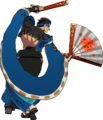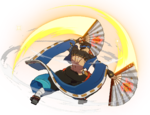It can be helpful to think of offense and frame advantage in terms of “turns”.
- When it's your turn, it means you have access to more options and/or time than the opponent, so you generally get to decide what happens next. You extend your turn using plus frames and gatling/cancel options to maintain the upper hand.
- Your turn ends when you use a move without cancellable recovery (e.g. a special move) that forces you to remain minus on block. In this case, you generally want to create as much space from the opponent as possible to return to neutral; otherwise, the opponent may be able to punish and begin their turn immediately.
Conditioning with frame traps and resets
Block pressure fundamentally consists of two main goals:
- making someone think it’s their turn, and then counterhitting them when they try to take it; and
- giving someone their turn when they don’t expect it, and then resetting pressure when they miss that chance.
A frame trap is a small window between two blocked moves that grants enough time for the opponent to begin an attack, but not enough for their attack to actually come out, getting you a counterhit. They punish the opponent for trying to interrupt your pressure and conditions them to sit and block.
Delayed gatlings are one way to implement frame traps in an otherwise true blockstring. However, if you just only tight strings and frame traps, the opponent has no incentive to stop blocking until your turn ends naturally. Effective pressure capitalizes on their passiveness and goads them into challenging perceived gaps.
The main way to do this is with a pressure reset: ending your turn prematurely with something that is technically interruptible in hopes that the opponent is not ready to respond. If the opponent wasn't ready and missed their chance to interrupt, you get to restart your turn.
A common way to reset is to fully recover from a blocked attack (while threatening a delayed cancel option) and start your turn again with another attack; this is called a stagger. Staggers are best used with close-range attacks that threaten strong frame traps while also being safe on block, such as Anji's c.S and 2P. If the opponent respects your frame traps, they are less likely to use abare options that would interrupt your staggers, allowing you more frequent resets.
Staggering into a throw instead of another attack is called a tick throw. This is important to call out opponents who will happily keep blocking your frame traps and staggers, and to force them to interrupt your pressure on suspected tick throw attempts.
Starting pressure from mid-range
The opponent blocking a longer poke is not necessarily rewarding for Anji, and requires some additional effort to convert into stable pressure.
- 5K on block opens up the most options for Anji when in range. 2D/6H gatlings threaten big counterhits that can let you get away with transitioning to close-range pressure once the opponent respects them.
- Further ranges offer more limited options and may be worth just ending your turn and noting how the opponent responds. Once you've established intent to return to neutral, or if the opponent tries to punish or force their own turn afterwards, you can start cancelling your longer pokes like 2S and f.S into Fuujin or Spin.
Starting pressure from close range
Once the gap is closed between him and the opponent, Anji is finally able to apply his strongest block pressure.
The key for effective pressure, as mentioned above, is leaving intentional openings to bait your opponent into trying to interrupt your pressure. Without the threat of staggers and tick throws, there is no incentive to mash out of gaps and the opponent can comfortably hold your blockstrings and frame traps until your turn ends on its own.
- c.S is Anji's strongest block pressure button. The threat of rewarding counterhits such as 2D, 5H, and 2H makes preemptive mashing a risky option for the opponent, enabling you to go to for tight tick throws and staggers.
- 2K and 2P are also effective for tick throws and staggers, due to their low blockstun and the threat of gatlings like 2D and 6H. Solid options when you're not comfortably in c.S proximity.
6H with Spin and Fuujin
6H frame traps after 2P, 2K, and 5K and advances towards the opponent with each hit. It's an important option to represent, as its existence makes staggers with those P/K normals scarier to challenge.
A useful property of 6H is being special cancellable when any of the hits connect.
- Fuujin acts as a frame trap immediately after the first or second hit of 6H; it is a true string after the final hit.
- Varying the hold duration makes Fuujin and Spin tricky to reliably hedge against. The threat of being counterhit by 6H/Fuujin allows for some greedier options like throwing after a short Spin, holding Spin to catch delayed attacks, or even Shitsu.
Fuujin on block, aka Chance Time
Blocking Fuujin puts both players into a pseudo-RPS situation where every one of Anji's options is technically punishable or interruptible, but in doing so the opponent must leave themselves susceptible to the other options. This interaction carries some risk but is necessary to represent Fuujin as a consistent threat and give Anji the leeway to reset and mix up elsewhere.
By effectively applying the threat of Fuujin and its followups, you can force your opponent to make riskier guesses than you do, skewing the risk-reward in your favor.
Will you use Fuujin at all?
- Cancelling unsafe normals like f.S, 5H, 6H, 2D, and 6P into Fuujin can stuff out opponents who show aggression or intent to punish after blocking.
- Once the opponent respects the threat of Fuujin and remains passive after blocking an unsafe move, that's a sign that you can start resetting pressure or safely return to neutral.
Will you use a followup?
- Fuujin with no followup is reversal-safe and demands respect once Nagiha is an established threat, letting you end your turn or go for staggers/resets. This should be your primary option to gather info about the opponent's defensive habits.
- Nagiha is your most reliable followup, being the safest option and a true blockstring if done immediately. Vary your timing to catch the opponent's attempts to punish empty Fuujin, interrupt the other followups, jump, or block Rin.
- Rin is an advancing overhead that calls out opponents focusing on empty Fuujin and Nagiha. Its low pushback makes it very unsafe without meter.
- Shin is interruptible with an anti-air on reaction, but lets you restart your turn if the opponent is preoccupied with the other options.
- Hop is typically not worth the risk in pressure; simply dashing in after empty Fuujin is harder to react to and opens up more options for less commitment.
Will the followup come early or after Fuujin?
- Kara cancelled Fuujin followups leave a large gap that the opponent can interrupt, though they will have to do so mostly on prediction. The main reason to use them in pressure is to trip up opponents whose reactions rely on the big green “FOLLOWUP INCOMING” indicator.
- Namely, kara cancelling makes Rin, Shin, and Hop more usable against opponents that are normally good at dealing with post-Fuujin followups. Kara Nagiha becomes a riskier option because the extra momentum counteracts the pushback that would otherwise make it pretty safe.
Resetting with Shitsu
Once heavy conditioning and respect have been established, you can start to include Shitsu as a greedy pressure reset in situations where the opponent is expecting Fuujin. Shitsu is punishable on reaction, so first consider your spacing and whether the opponent has a low-profile option or fast gap closer that can reach you.
If you do manage to get Shitsu out, the two hits can enable some huge staggers that let you back into close range to restart pressure.









![Fuujin, frame 16 [32]](/wiki/images/thumb/9/93/GGST_Anji_Mito_236H.png/150px-GGST_Anji_Mito_236H.png)




